Hazel Thornton's Blog
November 7, 2025
What’s in a name? (family naming patterns)

Who (or what) were you named after? I was named for my paternal grandmother, Hazel Islery Clay Thornton, the “bathing beauty” on the cover of my book What’s a Photo Without the Story? How to Create Your Family Legacy. My mom was named for her maternal grandmother, and my dad was a Junior.
Why are family naming patterns important?I love family naming patterns as much as I love family resemblances. They can be entertaining, helpful, touching, and mystifying. They can also help you find more ancestors and confirm your findings. How?
Entertaining: I find most of the naming patterns discussed in this blog post to be entertaining! My own mom named her children with rhyming first and middle names that are fun to say. I can’t list them all due to privacy considerations, but I can tell you the first two: Hazel Kay and Michael Ray.Helpful: Keep an eye out — one way you might get lucky is that the first or middle name of a child might be the elusive maiden name of the mother. (More on that later.)Touching: I recently realized that my 2nd great-grandmother Emma Cook Lawrence named her son (my great-grandfather) Horace Warren Lawrence in honor of her presumably-dear, closest-in-age brother, Harrison W. Cook. I knew about Harrison W., but not that he went by the nickname Horace and that W. stood for Warren. And not that he died in the Civil War when he was 20 and she was just 15. I found this to be not only touching, but also a helpful indication that I had identified the right wife for James Henry Lawrence.Mystifying: My maternal grandmother’s first name is Villa. Where the heck did that come from? And Norfulet Byrd. Is Norfulet a typo? A surname? And why did my mom say, before she died: “Oh, by the way, Emma Lawrence’s real name was Minerva Jane Kibby.” What?!?! I guess those are the opposite of patterns, but perhaps one day a pattern will reveal itself and help solve one of the mysteries.Not all families have strong naming patterns, but many do! It’s not something you can count on — I think it’s equally as interesting to note when a family did not follow a pattern, as when it did — but noticing them, and learning which common patterns might apply to your situation, can help you piece your ancestors’ families together and learn more about them.
Here are a few I’ve noticed:
English/Irish/Scottish TraditionHere’s the traditional naming pattern:
1st son named after paternal grandfather
2nd son named after maternal grandfather
3rd son named after father
4th son named after father’s eldest brother
5th son named after mother’s eldest brother
1st daughter named after maternal grandmother
2nd daughter named after paternal grandmother
3rd daughter named after mother
4th daughter named after mother’s eldest sister
5th daughter named after father’s eldest sister
In my family tree there are eight Thomas Thorntons. There are also nine James Reeds and six John Clays. My namesakes are, for the most part, spaced out enough in time that I am not confused. But you can end up with a real puzzle if all the sons in a large family stick together in one geographical location and they all name their sons in the same traditional manner. (Does this record pertain to the father, or to his son? Or maybe his nephew?)
The Biblical RobbinsesI have never found any direct evidence that the father of my 4th great grandfather, Noah Robbins, Is Daniel Robbins. Why, then, have I included Daniel, and Daniel’s father Isaac, on my pedigree chart? It’s because in genealogy we also consider indirect evidence. I know that Noah Robbins migrated from North Carolina to Indiana. And I know that a bunch of other Robbinses also migrated from North Carolina to Indiana in the same time frame.
From what I know of the individual families, from other records, the one that comes the closest to being in the right location at the right time, with other children around Noah’s age, is Daniel’s. The years when Noah might have been listed by name on a census with Daniel were pre-1850, the first year all household member names were listed with the head of household. Another clue is that all these related Robbins families had a tradition of giving their sons biblical names. This family is not unique in using biblical names, but I haven’t seen one that uses them as extensively as this one did.
Andrew, Daniel, Eli, Elisha, Elzey, Ezekiel, Hiram, Isaac
James, Jacob, John, Jonas, Jonathan, Joseph, Joshua, Josiah
Mathias, Michael, Moses, Noah, Solomon
I have seen only one use each of these biblical names in the applicable timeframes and locations. If there were another Noah in the same time and place, that would open it up for “my” Noah to belong to another family. But there isn’t another candidate family thus far.
What are the chances that Noah is not a member of this extended family?
I wasn’t even planning to mention the female names, assuming them to be a mixture of biblical and non-biblical. But I started looking them up and found out that more of them were biblical that I thought! A few examples:
Sarah – yes, of course. But also: Tabitha, Priscilla, Rhoda, Anna, Elizabeth, Keziah and Jessie.
The Virtuous QuakersMy Quaker ancestors go back as far as Quakerism itself, which was founded in mid-17th-century England by George Fox. That is, until they started marrying non-Quakers and committing other such infractions. (See Thornton Family History Lost and Found.)
Quakers (and Puritains) often gave their children names that reflected the virtues they wished them to be associated with. These are known as virtue names or grace names. Here are some examples from my family tree. They are all female names unless designated (m).
Charity, Reason (m), Patience, Grace, Thankful, Pleasant (m)
Unity, Temperance, Mourning (I don’t get this one either)
The Patriotic HendersonsAlthough the Hendersons in my family were Quakers, they were apparently also very patriotic, as shown by the names of this father and his sons:
Thomas Jefferson Henderson b. 1809 (Thomas Jefferson, 3rd U.S. President, 1801-1809)
Shadrack Jackson Van Buren Henderson b. 1839 (Andrew Jackson and Martin Van Buren, 7th and 8th U.S. Presidents, 1829-1841)
James Madison Henderson b. 1848 (James Madison, 4th U.S. President 1809-1817)
And, by searching my Ancestry database I found a number of instances, in completely different branches of my tree, of honor being paid to the Father of Our Country:
George Washington Cook
George Washington Keesling Sr.
George Washington Keesling Jr.
George Washington Lear
George Washington Boykin
George Washington Smith
George Washington Reed
Here are a few more patriotic examples:
Robert E. Lee Lawrence b. 1875 (Confederate General Robert E. Lee lived 1807-1870)
James Monroe Speed b. 1818 (James Monroe, 5th U.S.President, 1817 – 1825)
James Monroe Taylor b. 1866 (James Monroe, 5th U.S. President, 1817 – 1825)
Thomas Jefferson Thornton b. 1845 (Thomas Jefferson, 3rd U.S. President, 1801-1809)
Unusual first and middle names can be the best clues!Let’s look at Abraham Garr Henderson. His middle name — Garr — is his mother Eliza’s maiden name. If I hadn’t already known her maiden name it would have been worth a search to see if it might be Garr. Abraham is not even my direct ancestor. He’s my 2nd great-granduncle.
Although I’ve only included this one example, and you can’t count on it, it happens often enough to be worth keeping in mind. And that’s why you need to research the children and siblings of your direct ancestors as well as the direct ancestors themselves!
Reusing the names of your own deceased childrenThis might seem kind of morbid, unless you lived in a time and place where it was common. If it looks like you have duplicates in your tree, it might be that one child died and a subsequent child was bestowed with the same name. I don’t have any handy examples, but I’ve seen it in a few of my branches, and those of genealogy clients (before I retired).
AI Overview
It was popular in early American, European, and other cultures, particularly between the 16th and 19th centuries, to reuse a dead child’s name, especially when infant mortality was high. This practice was a way to cope with grief and preserve the family name and continuity. The tradition was so common that parents would give the same name to a new baby and would continue doing so until a child with that name survived to adulthood.
CatholicsWhile researching for one of my genealogy clients (before I retired), I encountered a family on the census with a large number of children. Although Catholics are known for having large families, or at least they were several decades ago, I didn’t know the family was Catholic. All I knew is that all of the boys on the census record were named Joseph and all of the girls were named Mary. What?!?!? As I was trying to figure out why, I noticed that all of their neighbors also had multiple children named Joseph and Mary! I’ve heard of drunk census takers, and those with sloppy handwriting, writing things down however they heard them, and relying on whoever answered the door to provide the information, but what was going on here? After a little Googling, I confirmed that some Catholics in some areas really did name all their kids Joseph and Mary. And all those kids in their daily lives go by their middle names: John, Thomas, Margaret, Elizabeth, etc.
African-AmericansOK, so this one’s not as entertaining as the others.
When tracing African-American ancestry, the process is the same as usual working my way back in time to 1870, the first census after the Emancipation Proclamation in 1863, and the first time former slaves were listed by name with their own families. Prior to that they were enumerated as property and, most often, not even recorded by their names but by their gender and age.
Some slaves, after emancipation, adopted the surnames of their former owners. But others chose new surnames for themselves, or adopted African naming patterns, to create a new sense of identity. So, while it is always worth looking in the area for a slaveholder with the same surname, it is not proof one way or another without additional evidence. What sort of evidence? Such as living right next door to the former slaveholder in question. Or being listed by name in their will. (See also Black Lives Matter in Genealogy Too)
Genealogy is a Matching GameRemember the children’s game called Concentration, or Memory, in which you turn over cards and try to remember where else you saw that same card? (There are many versions of this game, with many names.) During the writing of this blog post, but entirely unrelated to it, I was looking at the 18th century Byrds for a not-so-fun reason — to see if their wills listed their slaves by name, so I can add them to the . I found a brief court note that mentioned Enos Byrd’s probate administrator, Keziah. As soon as I populated her first name into Ancestry as probably being his wife, several hints popped up indicating that her father’s surname was Denby and her mother’s was — well, how ’bout that? — Norfleet. Ding, ding, ding! Remember Norfulet Byrd from earlier in this post? (I have also seen it as Enorfleet, Noflete, and Noffleet.) This is a strong indication that not only was Norfleet’s name commonly misspelled, but that I guessed right about Keziah being Enos Byrd’s wife.
Do you know where your name came from?
Does your family use one of these naming patterns, or a completely different one?
Please share with us in the comments below!
______________________________________________________Hazel Thornton is an author, genealogist, and retired home and office organizer.Book: Hung Jury: The Diary of a Menendez Juror Book: What’s a Photo Without the Story? How to Create Your Family Legacy Book: Go With the Flow! The Clutter Flow Chart Workbook Feel free to link directly to this post! Click here to ask about other uses.Copyright 2025 by Hazel Thornton, Organized for Life and Beyond_____________________________________________________________________________
The post What’s in a name? (family naming patterns) appeared first on Hazel Thornton.
October 12, 2025
Rabbit, rabbit!

Do you say, “Rabbit, rabbit,” for luck on the first day of the month?
Have you heard others saying it (or seen them posting it on social media) and didn’t know why?
Here’s how I remember it…
Girl ScoutsAt Girl Scout camp, in 1970s Idaho, we had a tradition, on the first day of the month, of circling our beds (or sleeping bags) three times, and saying, “Rabbit, rabbit!” thereby securing good luck for the rest of the month. It was supposed to be done first thing in the morning, before saying or doing anything else. (I don’t remember what you were supposed to do if your bed was shoved up against a wall. Perhaps some other Girl Scouts will chime in to clarify.)
FamilyWhen I came home and told my family about it, this practice somehow got morphed into a competition, whereby if one family member said, “Rabbit, rabbit,” to another, and that person had not yet thought to say it themselves, they were considered to have been “Rabbited.” Jinxed, in the mildest way possible. (They could not, in turn, “Rabbit” anyone else.) No one was actually wishing anyone ill, but it was fun to remember first and to “Rabbit” others. My mom took delight in that game and there was nothing I could say or do to restore it to its original format.
In any case, there seems to be no consensus on the original format.
I thought of it as a Girl Scout thing until the internet was invented and told me otherwise.
WikipediaIf you are the least bit interested in this topic, you will enjoy reading the Wikipedia entry. Here you can find some discussion about the murky origins and several variations of the tradition. Some folks are adamant that there should be THREE rabbits. (We definitely were saying, “Rabbit, rabbit,” but did we say it again each of the three times we circled our bed?) I say it depends on what you grew up with, same as with all traditions.
Origins: No one knows. It seems to be limited to English speaking countries, and the earliest mention anyone can find is 1909.
Variations: “Rabbits!”, “Rabbit rabbit”, “Rabbit, rabbit, rabbit”, “Rabbit, rabbit, white rabbit.” I have never read or heard of anyone else circling their bed while saying it, but some wait up until midnight the last night of the month so they can say it literally first thing the next month. One feature they all have in common, though, is that it’s a first-day monthly ritual with the goal of ensuring good luck.
NOTE: Don’t look too deeply into the tradition of carrying a rabbit’s foot for good luck. Yes, I had one as a child. It seems gruesome and unnecessary now.
AdulthoodThe family game waned a bit when we grew up and spread out to live across the country in several different states. Rabbiting via phone, text, email — and, theoretically, carrier pigeon — totally counts! Skywriting would be fun. And it waned even more when my mom died. But it never disappeared altogether.
When I started my Organized for Life business in 2004, my goal on the first day of each month became (and remains, in my retirement) to get my email newsletter published. So Rabbiting family members wasn’t uppermost in my thoughts. But I also never completely forgot about it.
FacebookEnter Facebook. I only have a handful of Facebook friends — Deanise, Roxanne, Kathy, Mark (RIP) — who post “Rabbit, rabbit!” on the first day of the month. They often include a cute bunny image, and I always enjoy it when they do. I think we could all use a little luck, so don’t be surprised if you see me posting, too, in the future. Not as a “gotcha”, but as a general well-wish to myself and others.
MoreHere are a few additional references to “Rabbit, rabbit”:
This is a Facebook page for those who celebrate: https://www.facebook.com/RabbitRabbitDayGoogle “Girl scout camp” and “Rabbit rabbit” to read this AI overview.This People.com article, like most other articles on the subject, is totally a regurgitation of the Wikipedia page.My friend and organizing colleague, Julie Bestry, while not a monthly “Rabbiter”, mentioned the tradition in this blog post: Organizing a Fresh Start: Catalysts for Success.NPR addressed the topic in this brief segment.As I was writing this post I discovered a “Run, rabbit, run!” prison superstition.I’ll bet you there’s a whole TikTok universe about this (#RabbitTok?), but I don’t have time to go down that, um, rabbit hole. But you can, and report back!
Do you observe Rabbit Rabbit Day?
Where, how, and from whom, did you learn it?
Is there something else you do for luck?
Does your family have another silly tradition or superstition to share with us in the comments?
______________________________________________________Hazel Thornton is an author, genealogist, and retired home and office organizer.Book: Hung Jury: The Diary of a Menendez Juror Book: What’s a Photo Without the Story? How to Create Your Family Legacy Book: Go With the Flow! The Clutter Flow Chart Workbook Feel free to link directly to this post! Click here to ask about other uses.Copyright 2025 by Hazel Thornton, Organized for Life and Beyond
_____________________________________________________________________________
The post Rabbit, rabbit! appeared first on Hazel Thornton.
October 3, 2025
Joyscrolling for your viewing pleasure

I keep hearing people complain about “doomscrolling”. It’s depressing and time consuming. But it’s not inevitable! I’m not sure if they get hooked on the gloom and doom in their news feeds, in the same way we sometimes can’t look away from a slow-moving train wreck, or if they just haven’t figured out how to avoid it (short of avoiding social media altogether, that is).
Avoiding it (while still participating in social media) is a function of settings, algorithms, and user behavior. The more you watch and click on gloomy subjects, the more a social media platform will think you like it and want to see more of it. Meanwhile, the less you interact with accounts you DO like — by “liking”, commenting, and sharing — the less you will see of them over time.
So, what is the alternative to doomscrolling? Joyscrolling!
Dang it, I thought I made that up, but I Googled “joyscrolling” only to find that I’m not the only one calling it that.
AI Overview
Joyscrolling is the act of intentionally seeking out and consuming positive, uplifting, or comforting content online to counteract the negative mental health effects of doomscrolling. Instead of obsessively focusing on bad news, a joyscroller curates their online experience to include inspiring images, videos, and stories that bring them joy, solace, or a sense of connection.
So I’m sharing some of my favorite accounts for your viewing pleasure. And I’d love to know some of yours! If you have one to share, or if you decide you like one of mine, please leave a comment below.
YouTube AccountsI discovered most of these creators on Facebook, Instagram, or TikTok. In recent months, almost all social media platforms have had issues that drive most creators to establish accounts elsewhere as well. They understandably don’t want all their eggs in one basket!
I, too, went through a social media decluttering phase, and updated this blog post accordingly, if you want to know where to find me: Clearing Social Media Clutter
Why YouTube?Because people complain when I include links to social media platforms. They either never had accounts there, or don’t anymore, and they have it in their heads that they can’t click on the links I provide and view what I am sharing. Sometimes it’s true (depending on how I shared it, or how they are viewing it). And sometimes, when they are asked to join the platform, they don’t notice that they can say no thanks and still view what I am sharing. Or they don’t think they can, so they don’t even try. But YouTube is for everyone. (Although there is a paid level for almost everything these days.)
 Plumes
PlumesThis French musician plays music for animals, usually on farms or in zoos. They love it!
https://www.youtube.com/@Plumesmusic/
 Miniature Cusina
Miniature CusinaMiniature Cusina is the practice of cooking tiny meals using real food and tiny pots and utensils, appealing to both cooking fans and collectors. This is my favorite cooking “show”. I like it partly because the videos are short, there’s no talking, and there are no fancy, long, distracting painted fingernails like I’ve found in almost all other close-up miniature videos (because it features a guy’s hands). Like their logo says: Real food. Real cooking. Real sound.
https://www.youtube.com/@MiniatureCusina/
 Island Ock
Island OckThis Long Island grocery store owner encourages local kids by rewarding good grades, acknowledging, celebrating, and building their confidence.
https://www.youtube.com/@Islandock1/
 Fernando Yumul
Fernando YumulMiniature Artist from the Philippines. I mean, he makes miniatures. Not that he’s a tiny person. I love seeing him transform everyday objects into entirely new (but familiar) things.
https://www.youtube.com/@Fernandoyumul1970/
 Mapic2
Mapic2German model railroad enthusiast with a cat who is unfazed. (Playlist: Katze vs. Gartenbahn)
https://www.youtube.com/@mapic2/
 Seanthesheepman
Seanthesheepman30-year-old shepherd and stockman working in Scotland with his 3 sheepdogs. Not only are his dogs amazingly talented, I also enjoy his choice of background music in most cases.
https://www.youtube.com/@seanthesheepman5845/
 Becorns | David M Bird
Becorns | David M BirdHe builds little people out of acorns and sticks, then photographs them in the wild with real animals. I like the videos that share his process.
https://www.youtube.com/@davidmbird

I find it very relaxing to watch her make botanical gel prints. (She does other things as well.)
https://www.youtube.com/@nadya_draws_in_seattle/
WebsitesAnderson Virtual Calming Room
I was looking for live animal cams — there are a gazillion of them these days! — and I found this local New Mexico site for students (and anyone) that not only includes a variety of animal cams, but many other ways to “boost your mood and help you refocus.”
https://www.mgt.unm.edu/calming-room/default.asp
PDX Sidewalk JoyA community of interactive sidewalk installations and exchanges around Portland, Oregon. These “installations” are all Little-Free-Library-adjacent. If you see something you like, you can make your own, wherever you live! (Or search for existing installations where you live.)
https://www.pdxsidewalkjoy.com/
Facebook Groups
Facebook Groups don’t have YouTube counterparts. And these are links to groups, not to individual videos, so yes, you probably do have to have a Facebook account to see much. But they are public groups, so (if you have a Facebook account) you don’t have to join the groups to peruse them. In fact, I have not joined any of them. But I’ve apparently spent enough time looking at their posts for Facebook to think I want to see more of them! I see plenty that way, and know where to find more.
Cookie Cutter Identification (CCID)Sometimes the mystery cookie cutter is identified; sometimes people make alternate suggestions for its use; other times people just get silly about it.
https://www.facebook.com/groups/cookiecutterid
Dollhouse miniatures made from everyday thingsThis group is about sharing ideas for making miniatures from scratch or found items. You can show off what you have made (ideally with some explanation) or ask questions about making miniatures.
https://www.facebook.com/groups/1675907215955924/
FREE PHOTOSHOP help, edits & requestsThere are a number of similar groups. As previously mentioned, I have not actually joined this group. And, in this case, I believe the benefit in NOT joining is that I don’t see their posts in my news feed until they have received a substantial number of replies. The replies range from, “Why do you want to do that?”, to totally awful amateur edits, to impressive expert edits, to hilarious and inappropriate edits. The range of reasons why people want edits is thought-provoking. And I wouldn’t want to see all the new requests and early discussion anyway.
https://www.facebook.com/groups/1154264053384266/
What’s your favorite source of internet Joyscrolling?
Might you try one of these?
Please share in the comments below!
______________________________________________________Hazel Thornton is an author, genealogist, and retired home and office organizer.Book: Hung Jury: The Diary of a Menendez Juror Book: What’s a Photo Without the Story? How to Create Your Family Legacy Book: Go With the Flow! The Clutter Flow Chart Workbook Feel free to link directly to this post! Click here to ask about other uses.Copyright 2025 by Hazel Thornton, Organized for Life and Beyond_____________________________________________________________________________
The post Joyscrolling for your viewing pleasure appeared first on Hazel Thornton.
September 7, 2025
Not all disabilities are visible
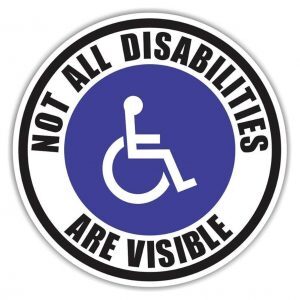
I think we’ve probably all heard the terms invisible illnesses and hidden disabilities. Yes? But if you don’t have one yourself, I wouldn’t blame you if you didn’t think about it very often. I didn’t either until I was diagnosed with one that affected my mobility. This post is to raise awareness and offer resources.
An invisible illness is any physical, mental, or neurological condition that limits or challenges a person’s life but is not immediately apparent to others.
People with invisible illnesses often appear healthy, even when they are experiencing severe chronic pain, extreme fatigue, cognitive difficulties, or other debilitating symptoms that significantly impact their daily lives.
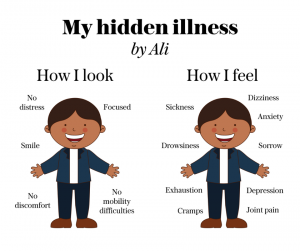
Click here to read “But you don’t look sick!” and to view a larger, clearer image.
Types of invisible illnessesThere are way too many types of invisible illnesses to list them all. A few that affect people I know personally are diabetes, autism, Crohn’s disease, POTS, kidney disease, multiple sclerosis, fibromyalgia, long COVID, and several forms of cancer. Some of these conditions start out invisible and become more apparent as they progress.
Many invisible illnesses affect mobility, but not always to the extent that an extremely visible wheelchair (or other mobility aid) is required. Most involve chronic pain and fatigue.
Multiple conditionsI hate the term comorbidities. It sounds so…well, morbid! And it wasn’t until COVID, when the term was used a lot to identify high-risk individuals, that I realized I have several of them. I’m not going to list all of mine, but when you look at me what do you see? I’m fat, I’m older, and I’m a woman. This is not a recipe for being taken seriously in society or by medical professionals. If you don’t agree with me, you’re probably not a fat, older woman!
When invisible isn’t exactly invisibleOMG, I wasn’t planning to elaborate, but I just saw this video (2:35 min.) and had to include it: Katie Couric interviews Dr. Mary Claire Haver on how being told to look out for “Whiny Women” shaped her career.
Obese people are obviously, visibly, fat. It’s easy to assume they are just lazy and eat too much food. But they can also have multiple other things going on with them that are “invisible”. They can have illnesses (or medications) that contribute to their obesity, and they can have illnesses in addition to being obese.
Fat can be classified in several different ways. For purposes of this post, I have TWO types of visible fat. One type is responsive to diet and exercise, but the other one is not. The fat disease I have — besides obesity — is called lipedema. If you’ve never heard of it, well, neither had I until a year or so ago. If I’d known about it, I could have asked about it by name and shortened the diagnostic period from several years to several weeks (or months, considering how challenging it is to get an appointment around here). I did point out my symptoms to every doctor I saw — heavy legs that were painful to the touch and seemed out of proportion to the rest of my albeit fat body — resulting in a few helpful half-measures, but not quite on the mark when it came to a diagnosis. There is no cure for lipedema, but I always think it’s better to know what’s wrong than to wonder. I’ve learned that there are many things I can do to manage it, and if don’t do all the things, it will get worse over time. And “managing” it doesn’t mean I can do everything I used to do.
Lipedema and lymphedemaLipedema is not rare, but it affects almost exclusively women and is extremely misunderstood and under-diagnosed. (As are many “women’s” diseases.) Since I don’t see lipedema on most lists of invisible illnesses, I asked Google about it.
AI Overview:
Yes, lipedema can be considered an invisible illness, despite its visible physical symptoms. While lipedema causes a disproportionate buildup of fat that can be seen, the underlying disease and the chronic, debilitating pain and fatigue that accompany it are often not understood or acknowledged by others, including medical professionals.
Many lip-edema patients (including myself) also have lymph-edema to one extent or another, or they are in danger of developing it. Everyone looks and feels different in the various stages and types of lipedema. Charts depicting the stages and types of lipedema also differ from each other, which is why I’m not including one here. If you see one, I’m not the worst case, but neither am I the best case. Some individuals have benefitted from surgery (a non-cosmetic form of liposuction), but it’s not a cure, and they still have to do all the things to manage it afterwards or it will return.
This post is not all about me, though, and is not meant as a lipedema tutorial, either. So allow me to leave you with some resources where you can learn more about it:
Printable PDF: “10 Things to Understand about Lipedema” is a good 4-page infographic of the basics.
Websites: The best sources for lipedema information are organizations like the Lipedema Foundation, The Lipedema Project, and Lipedema.com.
Social Media: Type the word “lipedema” into the search box on any social media platform to find lots of resources, different types of support groups, and individuals posting about it.
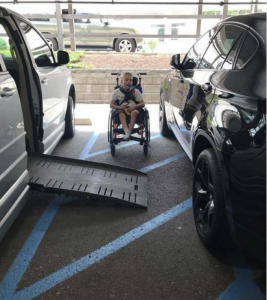
This is why you don’t park in the striped area of a handicap zone.
Mobility (or lack thereof) awarenessOne of the easiest ways of identifying someone with a disability is if they are in a wheelchair or using another mobility aid such as crutches or a rollator. These would be considered visible illnesses or conditions. As a result of mobility difficulties related to lipedema, I have, in my possession, a doctor-prescribed handicap parking placard. But I am not using mobility aids (except when I twisted my knee and used crutches for a while).
Do I use the placard? Yes, sometimes I do. Not always, though.
Whenever I drive somewhere there is a calculation involved:
Is there a parking lot where I’m going? (Or is it street parking, and how far down the street are we talking about?)Is there an open handicap parking spot available? (Often there aren’t enough.)How far from the front door is it? (Sometimes the spots are quite far from the front door. It’s like someone decided no one needs a handicap spot unless they have a wheelchair, and the wheelchair ramp is sometimes at the end of the building, quite far from the front door.)Are there regular spots available closer (or equally close) to the front door? (In which case I would choose one of those, so as to leave the handicap spot free for someone else.)To what degree am I feeling the need to park close to the front door today? (Some days are better than others.)I can’t say anyone’s ever given me a hard time for using a handicap parking spot, but I know others who have been given a hard time, and I always worry that someone will.
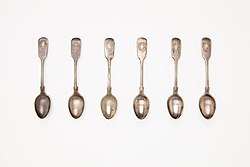
What is it? Here’s the Wikipedia definition:
Spoon theory is a metaphor describing the amount of physical or mental energy that a person has available for daily activities and tasks, and how it can become limited.
A lot of Spoon Theory articles and infographics pertain to neurodivergence. But that just means it applies to them as well as to those with other invisible illnesses. If you click here you are likely to find infographics and articles that pertains to your specific condition.
This isn’t about which diseases are “worse” than others. Even if two people have the same disease, their experience of it can be different in as many ways as they are similar.
I don’t personally use The Spoon Theory, but I think that’s mostly because I don’t have to explain myself very often to others. (“Sorry, I can’t accept your last-minute invitation; I’m down to my last spoon and that would take at least three.”)

Some invisible illnesses are temporary, and others are chronic. I once wrote a post called Organizing to De-Stress a Major or Chronic Illness. It was intended for both those who are ill, and for those who live with or care for them.
I’ve updated it a few times over the years, the last time being in 2019. Which, ironically, is around the time I was seeking my own diagnosis and not finding answers. So there may be a few outdated resources, but the major sub-topics are still good:
Organize Your Medical RecordsOrganize Your Support SystemOrganize Your HomeOrganize Your Self Hidden Disabilities Sunflower Program
Hidden Disabilities Sunflower ProgramThe Hidden Disabilities Sunflower lanyard, cards, and pins are simple tools for voluntarily sharing that you have a disability or condition that may not be immediately apparent. The program also provides ways for public places and services to indicate that they are aware and available to help you.
Although they feature a number of disabilities on this page, the site also has an index of 912 (!!!) hidden disabilities on this page (scroll down past the form). I was just about to submit “lipedema” when I realized they DO have both lipedema and lymphedema listed under their British and Australian spellings — lipoedema and lymphoedema.
I don’t know how well this worldwide program is catching on, partly because I don’t get out much these days. But I do know the Regional Director in Canada, Clare Kumar. (I already knew about the program before she started talking about it.) She has a Facebook group called Happy Space Pod, and a podcast called Happy Space Podcast. Check them out!
 Invisible illness awareness
Invisible illness awarenessWhat can you do to help? Well, for starters:
Remember: Be kind, for everyone you meet is fighting a battle you know nothing about. Share this post with others.For more info, Google “invisible illness awareness”. If you see someone wearing a sunflower lanyard or pin, be patient with them if nothing else. (Surely there are people who will wear sunflowers without ever knowing this program exists, because they are pretty. Eh — might as well be kind to them, too!)Keep in mind that the Hidden Disabilities Sunflower program estimates that 1 in 6 people has an invisible illness. That’s a lot of people!Do you, or someone you know, have an invisible illness?
If so, do you have any advice for the rest of us?
Please share in the comments below!
______________________________________________________Hazel Thornton is an author, genealogist, and retired home and office organizer.Book: Hung Jury: The Diary of a Menendez Juror Book: What’s a Photo Without the Story? How to Create Your Family Legacy Book: Go With the Flow! The Clutter Flow Chart Workbook Feel free to link directly to this post! Click here to ask about other uses.Copyright 2025 by Hazel Thornton, Organized for Life and Beyond_____________________________________________________________________________
The post Not all disabilities are visible appeared first on Hazel Thornton.
August 27, 2025
It’s not over for the Menendez brothers!
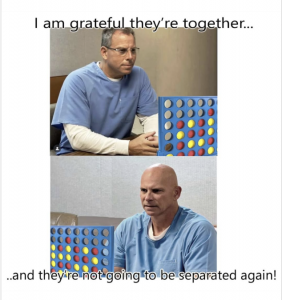
Meme credit: @thousand.foot.cliff
Parole deniedLast week Erik and Lyle faced separate parole board panels in record-breaking 10- and 11-hour long hearings, in their bid for freedom after 35+ years behind bars. Both were denied.
While that ruling disappointed all who support them, it wasn’t surprising to anyone who knew that parole is rarely granted on the first try. To those who think the hearings were rigged I say: So what else is new? The Menendez brothers can’t catch a break.
But it’s not overIt’s the beginning of the end, and there’s a light at the end of the tunnel.
How can I be hopeful after so long and so many disappointments? Well, for most of their incarceration, as LWOP (life without parole) prisoners, they had zero hope of ever being paroled. That’s what makes their transformation all the more remarkable. It was a miracle that they were resentenced after all this time and are now eligible for parole.
Blog post: Menendez Miracle #6
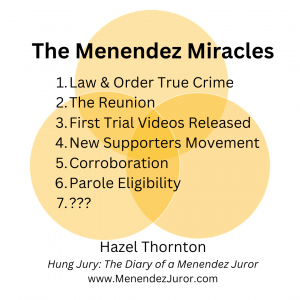
Come on, Miracle #7!
Take it from a close friend of Erik’s and Lyle’s — Anerae Brown, aka rapper X-Raided — who spent 26 years behind bars, and who credits the brothers for helping him succeed on his path to parole:
Why a Three Year Denial is good(It’s a TikTok. If you don’t have an account, and if it asks you to create one, just say no. You should then be able to watch it with no problem.)
Here it is in chart form (my favorite), from Instagram Menendez supporter @thousand.foot.cliff:
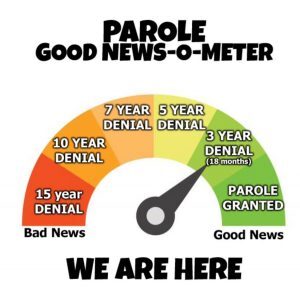
They were each given a “three-year denial”. This means on the surface that they are eligible to reapply for parole in three years. (Which is the best case for a denial, when you consider the other options are five, seven, ten and fifteen years.) But in practice, I’m told, they will likely have an administrative review after 12 months and possibly be approved to go back before the parole board in 18 months.
Was the hearing rigged? Attorney Mark Geragos certainly thinks so! Maybe the decision can be appealed, but meanwhile, Lyle and Erik need to be on their best behavior — better than best — if they want a favorable ruling next time.
Habeas Corpus PetitionIn July, Judge Ryan ruled that the two pieces of “new” evidence (easily Googled) “would have more likely than not changed the outcome of their second trial.” This is good news, but I hope to God there’s something that can be done here short of an actual third trial.
Here’s a fun fact for those who think the Netflix Monsters series started it all: The habeas petition was filed by the brothers’ lawyers two days after the Menendez + Menudo: Boys Betrayed documentary aired in May 2023.
ClemencyThis case has been a political football since the beginning. Governor Newsom can grant them clemency whenever he wants. Despite changes in societal understanding of the psychological effects of sexual abuse, and new laws pertaining to youth offenders, no one wants to be the one to let the Menendez brothers go free.
I think he believes them and wants to help them out, but he doesn’t want to ruin his political career over it. No matter how many thousands of new supporters the brothers have gained in recent years, there are still millions of others who hate them and think they should die in prison. And the new raft of media reports about the hearings are all focused on rule-breaking at the expense of describing their otherwise model citizenry. My prediction is that Newsom will approve the parole board’s decision if and when they eventually grant them parole, but that he won’t grant clemency on his own. I’m also completely open to being pleasantly surprised!
They’re not perfect
Lyle and Erik are flawed human beings. Who isn’t? They’re not angels, nor are they monsters. They did a terrible thing, in a spectacularly brutal fashion, and have spent 35-years-and-counting paying for it. They grew up in prison. They became responsible men who not only have improved and educated themselves, but who have also contributed to their prison society by leading and creating new programs so that others could succeed after they were released, even before they themselves had hope of being released someday.
The justice system has failed them time and time again. Prisons are not focused on rehabilitation, they’re focused on punishment. But maybe Lyle and Erik can help change that.
Blog Post: Inspiring Prison Programs
This is a portion of the mural at the RJ Donovan Correctional Facility. It is part of Lyle’s Green Space project, with Erik participating as lead painter.
It seems their worst crime in recent years has been forbidden cell phone usage. Does that mean they are a violent risk to society? Absolutely not! Does it mean they think they are above the law? Maybe so.
One of the parole commissioners expressed disapproval of the fact that brothers’ supporters only seem to know about the good things they’ve done in prison. Oh, c’mon! Could it be because most of the infractions were 20-30 years ago, before a lot of their new supporters were even born? Or that they weren’t egregious? The brothers have no direct access to social media and rely on their families to represent them there . (Fun fact: Facebook was introduced in 2004, ten years after the first trial ended.) How were they supposed to let us know every time they broke a rule? And what business is it of ours, anyway? I, for one, am happy with the reports I get of their progress and well-being and don’t need to be privy to their every thought and deed.
Fair or not, if they can avoid infractions for the next 18 months they will likely be able to go before the parole board sooner than three years and have a good chance of being approved next time.
Remorse and responsibilityDA Hochman is fond of saying the brothers have not yet expressed remorse for their crime and have not taken responsibility for it. Uh, where has he been? I have heard them publicly express remorse and take responsibility many times over the past three decades, starting when I sat in the jury box and watched their grueling weeks-long testimony in 1993 from ten feet away. Ask their families if they seem remorseful enough. I think the families should be the judge of that, not DA Hochman. (Don’t get me started on how the families have been treated over this past year.)
Imperfect self-defenseDA Hochman also loves to talk about how this wasn’t self-defense. Spoiler alert: THEY NEVER SAID IT WAS.
In the first trial their legal claim was Imperfect Self-defense.
Imperfect Self-defense is a legal doctrine in which a defendant killed another person while holding an honest but unreasonable belief that deadly force was necessary to prevent death or great bodily injury. It acts as a partial defense to murder, reducing a homicide charge to voluntary manslaughter rather than a complete acquittal. The defense applies when at least one element of a perfect self-defense claim is not met because the defendant’s belief was unreasonable, even if it was genuinely held.
I get why the general public doesn’t know about this, but DA Hochman should know better. Unfortunately his microphone is bigger than mine.
The brothers never said “we were right” that their lives were in imminent danger. They said, “we were afraid” and — because of the hypervigilance they developed during their abusive childhoods — they thought their lives were in imminent danger. (And the prosecution did not offer a single expert witness to refute it.)
This defense was disallowed, unfairly so, in the second trial. That jury had no choice but to convict them of first-degree murder. Mission accomplished, DA Garcetti and Judge Weisberg! Congratulations. Tell me again why you needed to be right, and not fair? Oh, that’s right, because you were being ridiculed in the press for losing high-profile cases. This chart helps to explain:

CLICK the image to view and print full-sized chart. “FINALLY” is, of course, from the POV of the DA, not from my own POV. Fun fact: Guess who the prosecutor was in the McMartin case? Pam Bozanich.
I wish I had thought to create this flow chart in the jury deliberation room, and not 20 years later. I wonder if it would have made a difference?

What’s YOUR verdict? CLICK the image to view, download, and print the full-sized (free) PDF chart. SHARE it with both supporters and doubters. Order your copy of my book here: Hung Jury: The Diary of a Menendez Juror
Too much focus on the past
Yes, they killed their parents, and in a spectacularly brutal manner. For that they have served 35+ years. (People forget, when they say 30 years, that they were arrested in March 1990.)
However, I did think that the focus of a parole hearing was supposed to be more about rehabilitation and whether they’d be a danger to society if released than about re-trying the original crime.
If we’re going to dwell in the past, though, let us not forget:
Two juries saw ALL of the evidence in the first trial. They were BOTH hung, with half of EACH jury voting for manslaughter, not murder. It was not mandatory that they be retried at all.The second trial jury saw only a portion of the evidence, with much of it being presented out of context. It was a travesty of justice, as I’ve described in the 2018 revised edition of my book Hung Jury: The Diary of a Menendez Juror .In their 2005 appeal, 9th Circuit Court Justice Alex Kozinski said he believed there had been “collusion between the DA’s office and Judge Stanley Weisberg” to manipulate the second trial to guarantee a first-degree murder resolution, not manslaughter as it should have been. In spite of his remarks, Justice Kozinski voted against the appeal and upheld the verdict. (Source: Justice Kozinski on Erik Tells All.)I still believe in miracles
I created this chart in 2017 and have been predicting and keeping track of the miracles ever since.

–> CLICK IMAGE TO VIEW & PRINT FULL-SIZED CHART
Everyone’s an expert these days
It used to be that only a handful of people were willing to speak up on behalf of the Menendez brothers in news interviews, articles, documentaries, and podcasts. Now the “room” (including all social media platforms, none of which existed in the early ‘90s) is so crowded that my introverted little voice is all but drowned out.
I used to wonder what could happen to make me change my mind about the case and the brothers. But if cell phones are the worst the parole board can dredge up in recent years, I’m still on board.
You will be, and already have been, hearing less from me, though, because (among other reasons) I’m 30 years older too. Social media platforms keep changing, and it’s hard to keep up.
I’ll be honest — I was hoping parole would be granted because I’m looking forward to this all being over for ME. I see any amount of vindication for the Menendez brothers as vindication for me, too, as a female juror who voted for manslaughter, not murder, and who has been mocked for it, by the uneducated and unsympathetic, ever since. Likewise, their supporters are my supporters. Including you, probably, if you’ve read this far. And for that I sincerely thank you!
Meanwhile, the story’s not over.
The question was always why?
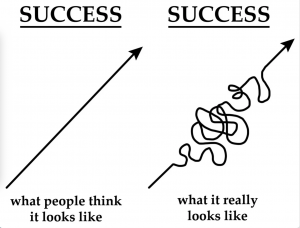

_____________________________________________________________________________
The post It’s not over for the Menendez brothers! appeared first on Hazel Thornton.
August 18, 2025
Why and how to write your own obituary

If you’ve followed me for a while, you’ll be used to me talking about death from time to time.
Planning my virtual funeral – who’s with me?Talking about death won’t kill you, LOL!“We Remember” our loved onesIs Swedish Death Cleaning for you?‘Death Cleaning’ isn’t as scary as it sounds! (4 short book reviews)Who will take care of us when we’re old?Are your keepsakes a legacy, or a liability?Legacy Resource RoundupOrganizing for Your LegacyAren’t You Dying to Know?Do You Have a Virtual Will?Several of these posts, as well as my book — What’s a Photo Without the Story? How to Create Your Own Family Legacy — advocate writing one’s own obituary, but I’ve never gone into much detail before.
In “We Remember” our loved ones, I mentioned that my dad had written his own obituary in the form of a farewell letter. (His actual death was a surprise, but he was a planner, like me.)
I even attended a little class once, from French Mortuary here in Albuquerque. It was PP (Pre-Pandemic) so I don’t remember a lot of it. I’ve got notes, and I know where they are, but I’ll admit I never finished mine.
Think of it as a first draft
I just read what I had written so far (in my French Mortuary notes) and it was pretty cringy. The fact is that we are NOT dead yet. As our lives continue, and our writing styles change, so our obituaries need to be reviewed from time to time, just like our wills.
My advice for dealing with the uncertainty and incompleteness of it all is this: Think of it as a first draft. If all you manage is some notes about your life, that’s better than nothing, and a good place to start.
RELATED BLOG POST: On Writing a First Draft

This mug was a freebie at the (also free) write-your-own-obit class.
Remember, you will be deadFor this to be a worthwhile effort, you will need to make sure someone knows you’ve written your own obituary (or jotted down some notes to help them out). They also need to know where to find it. Even if they end up using what you’ve written differently than you envisioned, it will be very helpful.
Why would they not use it just as you’ve written it? Here are a few reasons:
You can make it as long as you want for some memorial sites such as Ancestry’s We Remember.But you might want a shorter version for the local newspaper because those obituaries aren’t cheap!If you wrote it in first person, there might be a need for a third person version.You might also want shorter versions for other sites and social media platforms.BONUS TIP #1: Do your loved ones a favor and write short goodbye messages for different uses (personal, business). Let them know exactly which social media platforms and groups are important to you and how to access and contact them.
BONUS TIP #2: Include a photo you like with your obituary. You can always upgrade it later. But lord knows what someone else will pick on their own!
It’s not easy
I never said it was easy, but it doesn’t have to be hard, either! Here are Three tips for stress-free obituary writing, from French Funerals & Cremation. They’re talking in this post about writing an obituary for a loved one, but the tips also apply to writing one for yourself. Spoiler alert, the whole post is worth reading, but here are the high-level tips:
Don’t overthink itPut your feelings into wordsGet outside helpWhy should we bother?It’s the least we can do for our loved ones who will be grieving for us. I’ve heard a will referred to as “a love letter to your family”. And I think an obituary falls into that same category, don’t you?Who knows us better than we know ourselves? Who would write yours if not you? Do they actually know your history and what you would (and wouldn’t) like to be included?Maybe you don’t care what someone else would write about you. But is there a message you’d like to leave behind? Or a favorite charity you’d like people to donate to?
Fast forward to 2025:
Holy crap! I just asked Chatty G (Open AI’s ChatGPT) to write an obituary for me, not that my need is imminent. You just never know when you’ll be hit by that proverbial bus, though!
This was my prompt:
“Please write an obituary for me, based on what you already know about me. I’ll edit it from there. Thanks!”
I was surprised at how touching, funny, and accurate it turned out to be. I’ll definitely be editing it myself, but — for your amusement — I’ll share what Chatty G came up with in less than a minute: Obituary Draft (about me, by ChatGPT).
Notice that it ends with an offer: “Would you like help customizing it further—such as adding your favorite quote, listing specific survivors, or tailoring the tone (more lighthearted, formal, spiritual, etc.)?”
Next, I asked for some guidelines and received this: Elements of a good obituary — including downloadable Word and PDF templates! Click the link to learn more about each of these key elements:
Announcement of DeathBrief Biographical SummaryPersonal DetailsFamily InformationService InformationSpecial InstructionsClosing Sentiment (Optional)Even if you don’t write your own obituary, or finish it, take a look at the suggested elements and use them for taking your own notes to leave behind.
NOTE: You don’t have to use ChatGPT. And your mileage may vary depending on how much you’ve used it before (how much it knows about you); whether you have a free or a paid version; or whether you’re using a different AI tool altogether. Don’t even worry about using AI. Just Google “How to write an obituary” on any web browser these days and you will get tons of ideas! (Um, spoiler alert: Google uses AI.)
I hope you find this helpful!
Have you written your own obituary? Do you know someone who has?
Do you think you’ll want to try it now that we’re talking about it?
Why or why not? Please share with us in the comments below!
_____________________________________________________________________
Hazel Thornton is an author, genealogist, and retired home and office organizer.Book: Hung Jury: The Diary of a Menendez Juror Book: What’s a Photo Without the Story? How to Create Your Family Legacy Book: Go With the Flow! The Clutter Flow Chart Workbook Feel free to link directly to this post! Click hereto ask about other uses.Copyright 2025 by Hazel Thornton, Organized for Life andBeyond_____________________________________________________________________
The post Why and how to write your own obituary appeared first on Hazel Thornton.
August 11, 2025
Could You Live in a Van?

Once upon a time I wrote a blog post called Could You Live in a Tiny House? At the time, Tiny Houses were a trend both in real life and in the media. My perspective was based on having lived in a 200 sq. ft. small-t, small-h tiny house many years ago, long before I was an organizer and before I had accumulated many possessions.
In my response to one of the comments I wrote:
I fantasize about traveling in a tiny RV (like a Rialta). But not living full time.
Since then I have switched, fantasy-wise, from a Winnebago Rialta to a customized Mercedes Sprinter Van. The main attraction to a Rialta (besides the small, drivable size) was access to the driver’s seat from the living compartment, which most (but not all) vans also have. In the event that a quick getaway seems prudent, I don’t want to have to go outside and walk around to the cab.
But a Rialta is a Class B Motorhome. Plus, they are no longer being manufactured. And a campervan, aka van conversion, is even smaller than a Rialta.
Why a van and not an RV?
Trick question. A converted van is just a tiny RV! For more info on the various classes of RVs: What is a Recreational Vehicle (RV; Definition, Types, Dimensions & Costs and https://en.wikipedia.org/wiki/Campervan.
So, why, then? Stealth! To anyone else who also lives in a van it would be obvious that someone is living inside, but I want to be able to park anywhere and not necessarily have everyone know. Some van conversions involve extra stuff on the roof (satellite, decking, storage, solar panels), or flares (side panel pop-outs, not to be confused with RV slide-outs), or extra vehicle height which would also give it away.
Am I planning to buy a van?
Will I ever, realistically, buy a converted van and live or travel around extensively in it? No.
I am getting too old and fat for that. And I need more access to medical care than I’d like to admit. (I’m sure there are people older than I am on the road, but they are also probably in better physical condition.) I also think the learning curve might be too much to rent one for just an occasional weekend. And the van customizations I would want would be cost prohibitive.
But a girl can dream, can’t she? Do you cook all the recipes you collect? Or make all the crafts you have supplies for?
Meanwhile do all my social media feeds think I’m in the market and show me every possible van conversion, design tool, and #vanlife video because I watch them all? Yes!
And do I have a mental list of deluxe features I would insist on having in my hypothetical van conversion? Of course! Basically, the more cool stuff you have in and on your van, the heavier it is and the more it will cost in materials, labor, maintenance, and gas.
Wish list of features
For starters:
Cab access — As previously mentioned, I want direct access to the cab from the living area.Permanent bed — A bed takes up a lot of space, but who wants to have to reconfigure the dining area every day? They even have beds that power up and out of the way to the ceiling.Toilet/shower — This is usually one of the biggest sticking points in terms of space and cost. But there are lots of clever ways to have both. Some vanlifers use portable toilets and gym memberships for the shower privileges (Planet Fitness or Anytime Fitness). I’m a fan of outdoor showers, but not in cold weather or in a populated area. It’s fun to see the variety of ways people have managed to build toilet/shower compartments, often sliding away and converting into seating or counter space. This video shows one woman explaining How I Built A Shower In My Van Without Losing ANY Space, including pros and cons near the end.Wi-Fi — I’ve already mentioned “extra stuff on the roof”, but I would still need WiFi. My fantasy van would have a low-profile satellite-based Wi-Fi for internet access in the wilderness.Cooking — I wouldn’t need the fanciest kitchen, but I would need a stove burner, a microwave, combo airfryer/toaster oven, and small (but not micro) fridge/freezer.Windows — Some vans I’ve seen have too few windows. I would imagine there can be too many to maintain structural integrity, but I’d want as many as possible.Window covers — Most any kind of window covering will provide a degree of privacy, but the more expensive magnetic kinds do a better job of sealing off light coming from inside at night. I also like the kind that closes off the cab from the living compartment (so one doesn’t have to cover all the windows in the cab, too.Is vanlife for everyone?
Heck no!
Vanlife isn’t for everyone. But it’s fun to fantasize about! People seem to love it…until they don’t. LOL?
Here is one of a gazillion 60-second #vanlife tours: https://www.tiktok.com/t/ZT6f1K9bv/ Some are picture-perfect snapshots of van life (sipping coffee in a clutter-free designer van while gazing out at an unobstructed view of the ocean); some focus on adventuresome lifestyles; and others are more about the logistics of having to find places to park, shower, and dump their compost toilets.
And here is a short video by someone who had a #vanlife career for several years and finally stopped and is happily living in a house: https://www.tiktok.com/t/ZT6fVyKfM/ (By “#vanlife career”, I mean she earned money as a social media influencer.)
Keeping a van organized
Most van occupants will admit they spend a lot of time tidying up and sweeping dirty floors. This is due to lack of space, an outdoor lifestyle that gets things dirty, and pets. You’d be surprised how many vanlifers have pets (usually, but not always, dogs).
As you can imagine, with space at a premium, it becomes even more noticeable when things are lying about. You have to be much more intentional about what you own, and how you store it, than if you had more available space. Think more about what you’ll need, and less about what you like or want.
Granted, I have not lived in a van or any other type of RV. But I’ve camped, backpacked, and traveled — and organized — enough to say the same organizing principles apply: Give each item a “home”; keep like items together; decide how much of any item you will keep on hand; don’t overflow your containers; make use of vertical space; put things away after you use them. And if you decide you need a gadget to containerize items or subdivide a space, measure a couple of extra times to be sure it will really do what you want and fit the space.
Additionally, though, and different from organizing a regular home, thought must be given to securing items so they don’t shift around while driving.
I think the best way to get ideas for van storage is to see what other people are doing. They’re (usually) not professional organizers, but they often will say what worked for them and what didn’t. Here’s a ton of Van Storage Ideas (Google Image search results).
A few more resources
VanSpace 3D — This is not the only tool available for designing a custom van layout, but it’s the one I’ve seen mentioned most often. I think it would take me for-e-ver to design a van, even with a definite wish list and a fantasy unlimited budget, because I know everything I want won’t fit.
Harvest Hosts — This site gives you access to unlimited overnight stays at farms, wineries, breweries, golf courses, community hosts & more. This is more fun than a Walmart parking lot, which is usually still good in a pinch. National parks are awesome, too, of course, but the rules about overnight parking, pets, etc., vary widely by location.
Vanlife Academy — This site provides “how to” lessons on every aspect of van life. Some are free and some are paid.
What about you?
Do you have an RV? Ever lived in a van? Ever wanted to?
What tips do you have to share with us?
Please share with us in the comments below!
______________________________________________________Hazel Thornton is an author, genealogist, and retired home and office organizer.Book: Hung Jury: The Diary of a Menendez Juror Book: What’s a Photo Without the Story? How to Create Your Family Legacy Book: Go With the Flow! The Clutter Flow Chart Workbook Feel free to link directly to this post! Click here to ask about other uses.Copyright 2025 by Hazel Thornton, Organized for Life and Beyond
______________________________________________________________________________
The post Could You Live in a Van? appeared first on Hazel Thornton.
July 24, 2025
Stocking Up
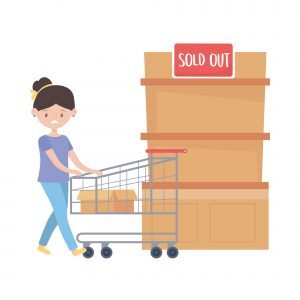
I just stocked up on something that might not interest you in the slightest. But it gave me peace of mind. And I’m curious what items you have stocked up on, and why.
In this post “stocking up” on something means to buy a large quantity of it, to have on hand for future use because you reasonably suspect, or know for sure, that there will be a future shortage of it. I’m not talking about buying a few extras of something you use all the time because it’s convenient to have them on hand. I’m not even talking about emergency supplies, which are also good to have, but which may never be needed, kind of like insurance. You can find some lists online and in my Emergency Preparedness Resource Roundup to help you prepare for natural disasters. But some of the same considerations definitely apply to all categories of extras, like how much you want to invest in them and how you will store them.
I know, I know — I’m usually talking about decluttering. (Exhibit 1: Go With the Flow! The Clutter Flow Chart Workbook.)
So you may be surprised to hear me saying there’s nothing wrong with stocking up on things.
This topic goes hand in hand with a previous post: Keep or Toss? “But I might need it someday!”
When is something worth stocking up on?I say it’s worth stocking up on something if:
It’s your favorite thing that you use all the time, and it becomes scarce, or actually discontinued, and there seems to be no good substitute.You have the space to store it without sacrificing living space.You can find it when you need it. There’s no sense in piling things up that you can’t use because you can’t find them, or that you don’t use because you forgot you had them!You can afford it, financially.It requires little or no maintenance. It won’t spoil, or you have a system for swapping out expired items.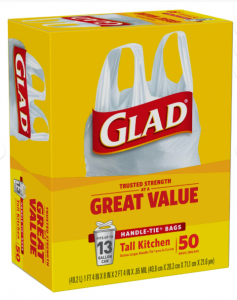
Discontinued Glad handle-tie trash bags (my favorites)
So, what did I stock up on?I stocked up on Glad Handle-Tie 13-gallon white kitchen trash bags.
Why? Because I like them and I learned they’ve been discontinued. Boo! I thought they just weren’t available anymore in my particular local stores, so I’ve been buying them on Amazon. (eBay is another good source of discontinued items.) Soon, although they may still be technically available for awhile because someone else stocked up and is selling theirs at a premium price, they may become un-affordable and not worth it to me anymore.
How many did I buy? $100 worth. Two packs of 4 boxes = 8 boxes x 50 bags each = 400 trash bags. That’s $0.25 each. I’m sure they were cheaper last time I bought them, and I see they’re already selling for more than that. This is it. I do not plan to buy more.
What if you run out? Well, it’s not if, it’s when they run out. I’ve bought myself plenty of time, I think, to 1) not worry about it for awhile, 2) mentally adjust, and 3) find a suitable replacement. At a rate of two per week, these will last 4 years. (Depends on how I actually use them, of course. Just for fun I asked Chatty G (ChatGPT) how many uses it could think of for trash bags and here’s the list it came up with.)
How much storage space do they require? 9″ x 14″ x 18″ = 1.3 cubic feet.

(I haven’t opened the box they came in yet, or put them away. I do have a spot for them, though, and it’s not in the living room!)
Why do I like them so much? If I told you, it would just make you want them too, and you would buy them all up! No, not really, I’m sure you’re doing fine with whatever trash bags you already like. But I prefer the handle-tie ones. In case you’ve never paid attention to them, the handles are individual loops that you, um, tie together. They’re easy to use, hold as much as I need them to, don’t get too full or heavy, and they feel comfortable in my hand when carrying them out of the house to the trash bin. (Or whatever else I do with them.)
Meanwhile, I actively dislike all of these other varieties of trash bag: drawstring, twist tie, elastic drawstring, flap-tie (aka cross-tie or quick-tie). I also dislike flex trash bags. Why? Because they’re designed to hold not only bulky items, but more items. I don’t need them to hold more items! Just like purses, backpacks, and luggage, more items generally means a heavier bag.
How does stocking up work with organizing, decluttering, and minimalism?In The Trouble with Minimalism, I wrote (favorably) about The Minimalists’ 20/20 Rule. Basically, anything they can replace for less than $20 in less than 20 minutes from their current location goes away. They do not get rid of things they use every day; only items they are saving just-in-case that are cluttering their lives unnecessarily because they might, in fact, never need them at all.
In my case, I can no longer get my favorite trash bags easily, or for a reasonable price, because they’ve been discontinued.
Then there’s my free Keep or Toss? “But I might need it someday!” chart, which weighs the Realistic Chances of Needing it Someday, against the Replacement Cost (Time + $$ + Energy), against the Potential Space Recovered. Basically, the lower the chances of your needing or using an item; the lower the replacement cost; and the greater the potential space recovered, the more likely it falls into the Toss category. (Toss = purge or let go of by donating, recycling, gifting, selling, or throwing away in the trash.) For more advice about setting limits read this post: A bag of bags. A box of boxes.
In my case, it is worth it to me to spend the money and devote the storage space to a stash of my favorite trash bags.
What have YOU stocked up on? Or considered stocking up on?
Why? Were you glad? (Ha ha, just noticed the pun in proofreading, yes, I’m Glad!)
Or, did you simply manage without, or find a suitable replacement?
Are you overstocked on something you could get rid of to free up space and mental energy?
Please share with us in the comments below!
______________________________________________________Hazel Thornton is an author, genealogist, and retired home and office organizer.Book: Hung Jury: The Diary of a Menendez Juror Book: What’s a Photo Without the Story? How to Create Your Family Legacy Book: Go With the Flow! The Clutter Flow Chart Workbook Feel free to link directly to this post! Click here to ask about other uses.Copyright 2025 by Hazel Thornton, Organized for Life and Beyond
______________________________________________________________________________
The post Stocking Up appeared first on Hazel Thornton.
July 11, 2025
The Sound of Music
 Theme 1: Prologue
Theme 1: PrologueThis is a story about growing up with my mom and music.
It’s easier for me to write about distant ancestors than it is to write about people I actually knew. Sometimes I get overwhelmed, partly because I know so much about them. I think: “I can’t include everything, but how can I narrow it down?” Or, “I need photos, dates, and evidence to back up my memories.” Or, “This will open a can of worms.” Or, “Who cares about this, anyway?”
Yes, I have many of the same thoughts that prevent many of you, too, from writing about your families. What do you think inspires people like me to write books like What’s a Photo Without the Story? How to Create Your Family Legacy – ?
So this story will be, by definition, imperfect. Imperfect in that it can’t possibly include everything, not even everything having only to do with music and (mostly) limited to a 12-year period of time. It’s a blog post, not a book.
After doing some newspaper research and getting overwhelmed by the number of times my mother was mentioned in conjunction with music, I allowed myself to simply reminisce.
I did not go digging through the family photos, many of which are still in Mom’s Boxes, or sort through my pile of piano music (and hers) for more titles. I did Google a few pieces that came to mind, and have provided links for your listening pleasure. OK, they’re for my listening pleasure, but I hope you enjoy them too!
Maybe there will be more later, but for now there’s this. I encourage you to just start somewhere and write what you know, too. You can add to it later if you want to.
Theme 2: Childhood
Growing up, our house was always full of music, thanks to my mom. At any given moment one could hear Mom playing the piano or marimba; classical or popular records playing on the stereo console; one of us kids practicing an instrument (piano, guitar, violin, clarinet); or Mom giving piano lessons or accompanying a singer rehearsing for a performance.
More than a Minister’s WifeMost minister’s wives contribute to their church communities by supporting their husbands both publicly and behind the scenes, by planning and hosting events, and by offering aid and guidance to church members. My mom did all that while also being in charge of the music. If we weren’t at home or school, we were likely at church. When my three younger brothers and I were very young we sat in the front row during Sunday services while my dad preached and my mom played the organ. We tried our best to behave and to avoid nodding off. When we were older we, too, participated in youth groups and choirs. In addition to playing the organ, she accompanied various soloists, choirs, and ensembles on the piano. I’m only realizing now that her “Choristers” group was a secular group called The Boise Choristers.
In addition to playing classical, religious, and popular music, Mom liked to improvise. One of her favorite techniques was to play only the black keys. (Huh. I just found a YouTube tutorial about this. But she was doing it 50 years ago.)
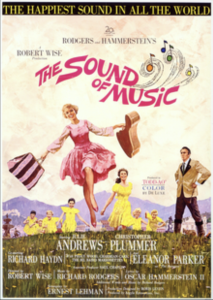
When I was 8 years old, my mom took me to see The Sound of Music. It was released the same year we moved to Boise, Idaho (1965). It was not only a wonderful, commercially successful, award-winning movie, it was also memorable to me as the first film we’d ever seen together, in a theater, just us girls. So I felt special. Naturally, I think of her whenever the movie or one of its songs comes up, which has been countless times in the subsequent decades! She also took my little Brownie troop and my oldest younger brother to see Mary Poppins (another Julie Andrews musical) while we still lived in Cayuga, Indiana. It was our first movie in a theater!
BandshellHow many times did we drive (or walk) down to Julia Davis Park, lay out a picnic blanket, and listen to a community band playing John Philip Sousa marches? Every 4th of July, for sure, but there were other times, and other types of music, as well. I Googled bandshell and was pleasantly surprised to see that the first Wikipedia photo example was our bandshell in Julia Davis Park! (What were the chances of that?!) I vaguely remembered there had been a fire, but did not know that it had been restored and renamed for jazz musician Gene Harris. (Here’s an article about its history. And this page shows additional views including one from the grand opening performance in 1928.) I suppose this is where my love of outdoor concerts began.
Piano LessonsMom was my first piano teacher. After a couple of years, when we moved from Cayuga to Boise, she signed me up with Probably, if you had asked her, she would have said I had outgrown her capabilities for teaching me. But I think it was also to avoid mother-daughter squabbling. Also, I realize now that there probably were no other piano teachers in Cayuga. (There were no movie theaters, either. She had to drive us to Danville, Illinois for that.) Years later, she taught piano lessons again in our home to supplement her income.
I took lessons between the ages of 6 and 19. My brothers took lessons as well, but only for a few years each. When I was 17, Mom bought a Baldwin grand piano, which was so much nicer than our old upright that it became a pleasure to practice the hour or more a day that my teachers recommended!
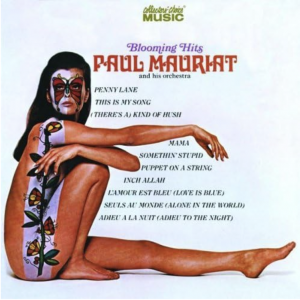 Puppet on a String
Puppet on a StringOne summer she bought Blooming Hits, an instrumental album by Paul Mauriat and his orchestra. The album spent five weeks at number one on the charts in 1968. We visited her parents in Albuquerque, and I remember dancing around like marionettes in Grandma’s living room (the only room with a swamp cooler) to the tune “Puppet on a String”. I’m talking Mom, and all of us kids, and maybe even Grandma, briefly. I see now that the whole album was only 26 minutes long. It was the soundtrack of our summer.
Here are some other things I remember listening to and watching as a kid:
Bunky the Monkey (A 10-minute children’s story with a symphonic background.)
Smothers Brothers Boil that Cabbage Down (This is a link to a television video clip, but we had the Golden Hits of the Smothers Brothers Vol 2 album.)
Peter and the Wolf (Young People’s Concert: “Young Performers No. 1” / Bernstein · New York Philharmonic. Did you ever watch that series?)
Walt Disney’s Fantasia (We saw the movie in a theater. Here’s an iconic scene: Sorcerer’s Apprentice).

Walt Disney’s Fantasia — The Sorcerer’s Apprentice
Popular MusicMy first three albums as a teenager, which I requested and received for Christmas all at the same time, were Carole King – Tapestry; Paul McCartney – Ram; and Gordon Lightfoot – If You Could Read My Mind. So, 1971. And I remember buying Moody Blues – Every Good Boy Deserves Favour with babysitting money as a surprise gift for my mom. We had heard it somewhere and she had loved it. My plan, which worked satisfyingly well, was to just start playing it and see how long it took for her to realize what it was. Then I told her it was hers.
Theme 3: PerformancesFestival
For at least six years in a row, I played in the National Federation of Music Clubs (NFMC) Junior Festival. This involved memorizing two pieces (one required, one elective) and playing them for a panel of judges (and a roomful of other students and their parents). It wasn’t a competition with the other students, only an evaluation of one’s own skills and improvement. There was a range of ratings, the top being Superior. For every three Superior ratings, in three successive years, I was awarded a Gold Superior certificate, which happened twice. (Nowadays they apparently hand out gold cups instead of certificates.) I say I played “at least six years” because there were also a time or two when I “only” got rated Excellent.
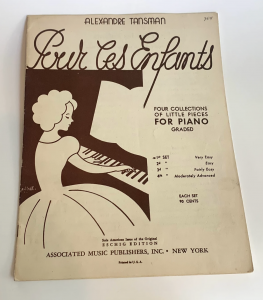
In addition to Festival, there were piano student recitals of various types, school talent shows, and church performances. Mrs. Hoshaw sometimes took us to nursing homes to play for seniors. During that time my pieces came from Pour Les Enfants, a book I’ve been known to play through, cover to cover, as an adult. It only takes about 12 minutes because I only ever had the first book, pieces 1-12. Not only is it meant for children, the difficulty level is also clearly labeled Very Easy. I was always insulted by that because, at the time, they did not seem very easy to me!
Alexandre Tansman – Pour Les Enfants
Later there were Bach inventions. These two in particular:
Bach — Invention 13 in A Minor
DuetsMrs. Hoshaw had two pianos in her basement, where she taught lessons. She lived within walking distance of my house. I remember practicing and performing two-piano pieces in recitals with other students. And my mom occasionally convinced me to play duets with her (four hands, one piano), but this is the only one I remember, because it was simple and fun:
Holsinger’s MusicAfter my youngest brother started school, Mom got a job working at Holsinger’s Music, where she worked for years at both locations. I, too, worked there (downtown) as a teenage stock girl. And my middle younger brother used to help move pianos for them. We all made good use of our employee discounts!
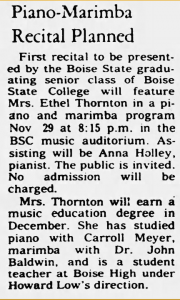
Idaho Statesman 1973
Boise StateBefore I finished high school, my parents divorced, and Mom went back to school. She got a degree in Music Education at Boise State University (BSU), having previously graduated from Pacific Bible College in Long Beach, CA, where I was born. (I was born during finals, and she had to take one of her exams in the hospital!)
I, too, was a music major one semester, but it was mostly so my piano lessons would be free. To qualify, I had to take a bunch of other music classes, too, but it was never something I was thinking would be a career. By the same token I was an art major for a semester so I could have a locker in the art building. I only attended BSU for three semesters before taking a year off, moving to California, and eventually studying engineering.
Mom always said I played better than she did technically. She was referring to things like fingering, timing, and articulation. But she far surpassed me in musicality, improvisation, sight reading, composition, and transposition. If you know me today you might think I would have loved the Circle of Fifths, but I hated it. It just never “clicked”. I loved my childhood piano teacher, Mrs. Hoshaw, though. And I took great satisfaction in getting a piece, as she would say, “down to a gnat’s eyebrow”.
At BSU Mom and I had the same piano teacher, but not at the same time. I just found out (by Googling his obituary) that performed Gershwin’s “Rhapsody in Blue” for the inaugural concert of the Morrison Center of the Performing Arts in 1984.
Morrison CenterThe Morrison Center for the Performing Arts wasn’t built until after I moved away from Boise. Prior to that, though, it had to be conceived, designed, approved, and funded. The closest my mom and I ever came to a political discussion was this:
Mom: Don’t forget to vote for the Morrison Center!
Me: I was planning to, but what if I didn’t want to? I can’t believe you are trying to influence my vote!
(Note: Current national politics would be the death of her, if she were still alive to see it.)
MusicalsIn addition to regular student recitals and graded performances, Mom participated in theatrical productions like these:
Fiddler on the Roof — I think she was part of the chorus in this one, as was my middle younger brother.
Amahl and the Night Visitors — I don’t remember what she did in this one, but I seem to remember it involving a middle-eastern-ish costume.
Jacques Brel is Alive and Well and Living in Paris — She performed as part of the 5-person orchestra, along with jazz musician Gib Hochstrasser, whom we all knew from working at Holsinger’s Music.
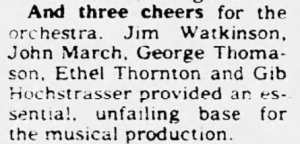
A portion of a glowing review of Jacques Brel is Alive and Well and Living in Paris. Idaho Statesman 1974
Of course we watched all the musicals available to us — on TV, in movie theaters, and (less often) on stage — West Side Story, Brigadoon, Seven Brides For Seven Brothers, The King and I, Godspell, and more. I have not kept up very well, though. For example, I’ve seen Hamilton, but only on TV, and only once. Sorry to disappoint my theater friends!
Theme 4: Young AdulthoodClavinova
I left home, at age 19-1/2, the day after our church burned down. I swear I had nothing to do with it! And I did not have a piano during most of my young adult life. At one point, though, I owned a Clavinova — a very nice, full-sized keyboard, with 88 weighted keys, plus a matching bench, that looked like a piece of furniture. It also had recording capability.
That year the whole family gathered at my house for Christmas. We all lived in far-flung states and rotated hosting family events. One night Mom played a recital for us. I wanted to record her performance, but she wouldn’t let me. I am still sad about that. She played everything she knew, and she played it well. We didn’t know there wouldn’t be another chance. The performance lives only in our memories. (There are no recordings of me playing either, so there’s that.)
Here are two of my favorites:
Debussy – Claire de Lune (I, too, enjoyed playing this one, mostly after she was gone.)
Rachmaninoff – Rhapsody on a Theme of Paganini – 18th Variation (Remember that time travel movie — Somewhere in Time — with Jane Seymour and Christopher Reeve?)
Theme 5: RepriseMom’s Piano
When she died, in 2001, my mother left me her Baldwin grand piano. Was I grateful? Yes. Is it sitting in my living room? Yes. Do I play it? Yes and no. Sometimes. Not lately. Never for an audience. Why not? Well, that’s a whole ‘nother story. Maybe I’ll tell it sometime, and maybe I won’t.
I can’t play anything close to as well as I did before I left home. But, in case you’re curious, here’s where I left off in my piano studies:
Brahms – Rhapsody Op. 79 No. 2 in G minor (This was the last piece I played for an audience.)
Chopin – Etude Op. 10 No. 3 (I don’t remember performing this in public, but I played it a lot.)
Oh, I could probably still play the first movements of each, but certainly not the more challenging movements, and not completely by memory like I used to.
Theme 6: Coda
Here’s more — but by no means all there is to know — about my mom:
We Remember (a belated, bare-bones Ancestry memorial including a few photos and an obituary from the Idaho Statesman)
Mom’s Boxes Part 1: The shed (a 9-part blog series)
There are a few stories about her in my book What’s a Photo Without the Story? How to Create Your Family Legacy.
Gifts I Got from Mom (blog post)
That’s all for now.
Thanks for listening!
(I’m already thinking of things I could include but didn’t.)
Was there a “theme” to your life? What was it?
Have you ever tried writing about it? How did it go?
Please share with us in the comments below!
______________________________________________________Hazel Thornton is an author, genealogist, and retired home and office organizer.Book: Hung Jury: The Diary of a Menendez Juror Book: What’s a Photo Without the Story? How to Create Your Family Legacy Book: Go With the Flow! The Clutter Flow Chart Workbook Feel free to link directly to this post! Click here to ask about other uses.Copyright 2025 by Hazel Thornton, Organized for Life and Beyond
______________________________________________________________________________
The post The Sound of Music appeared first on Hazel Thornton.
May 26, 2025
Inspiring Prison Programs

This is a portion of the mural at the RJ Donovan Correctional Facility. It is part of Lyle’s Green Space project, with Erik participating as lead painter.
Now that Erik and Lyle Menendez are eligible for parole — Menendez Miracle #6 — it no longer seems pointless to think about what they might do when they get out of prison.
RehabilitationThe brothers have said that they’d like to continue the work they started in prison.
From Lyle’s resentencing statement:
I have worked hard to be a better person. I have taken on roles in inmate government, learning to help others solve problems, and in doing so, I began to develop greater self-worth and compassion. I have participated in self-help groups…built strong, healthy relationships with correctional staff, therapists and fellow inmates. I have learned to access professionals for support…I have learned to process anger instead of burying it…I have learned to ask for help when I need it.
If afforded an opportunity for another chapter of life beyond the prison walls, I plan to continue working with the sex abuse survivor community to spread awareness. I also plan to continue to serve the incarcerated population through community building to change the culture of corrections.
From Erik’s resentencing statement:
I was given the opportunity to serve others. I began caring for the elderly, the disabled, and the terminally ill. It may seem small, but that act of service changed everything for me. I mattered to others. I had purpose. I created the Life Care & Hospice program, and through that work, I discovered a new way of seeing life. I started focusing on living with purpose. I began to understand what it means to form a real connection — even in here. To be part of a community. To show up as a husband and a father, even from behind these walls. I began getting involved in self-help programs. I started educating myself, and then I began leading and encouraging others.
It’s this same sort of self-improvement and rehabilitation that Lyle and Erik hope to continue engendering in other inmates through special programs. The fact that they were mentoring other inmates while they, until now, had no hope of parole for themselves, speaks volumes about their characters.
Why Special Inmate Programs?

Erik Menendez created this logo for the Helping Without Prejudice Foundation.
I’ve learned that while the United States has 5% of the world’s population, it has 25% of its prisoners. The cost to taxpayers is $80 billion per year. The recidivism, or relapse, rate is 75%.
Meanwhile, the prison system in Norway has a recidivism rate of only 20%. This is inspiring and is known to have inspired the Menendez brothers, too.
Here’s a quote from the Halden Prison video I’ve linked to in the next section of this post:
It’s basically inserting humanity into the prison system…The punishment should be loss of freedom, not loss of dignity.
At the end of the day this is not just good for the prisoners and the prison, but society as a whole… the hope is to prepare inmates for life after they get out. Moving away from managing prisoners to creating good neighbors.
Prison Documentary Rabbit Hole
I’ve watched several documentaries recently about programs designed to humanize and rehabilitate inmates. In addition to benefitting the prisoners themselves, the programs have a positive impact on the prison system, the inmates’ families, and the nearby communities who either directly, or indirectly, benefit from the improved condition of inmates who are released.
Documentaries I’ve seen: Unleashing Hope: The Power of Service Dogs for Children with Autism — Hulu trailer on YouTube — Dogs are trained by Guide Dogs of America and inmates at Richard J Donovan Correctional Facility where Lyle and Erik are living.The Quilters — Netflix trailer on YouTube — Inmates make quilts for local foster children.EP 1 | PRISON CAT, GALILEO | THE CATS THAT RULE THE WORLD | SHEBA® — YouTube (20 min.) — A program in which inmates partner with the Humane Society to care for cats and get them adopted.Women inmates find hope with safe choir — YouTube (6 min. news segment)World’s Most Luxurious Prison | Halden Prison: Vacation For Murderers? — YouTube (45 min.) — I watched this one because Lyle and Erik have talked about being inspired by the Norwegian prison system.Related:Sing Sing — HBO Max trailer on YouTube — A film about the true story of a group of incarcerated men at ‘Sing Sing’ prison who participate in a theater program.Seeds of Change — PBS trailer on film’s website — An organic farmer in Maine sets out to transform the prison food system. (Since I haven’t seen it, it could be more about the farmer than the prisoners, but either way, I like the title.)6 Inspirational Prison Reform Documentaries You Need to Watch (article with embedded videos) — I saw the first one a while back and recommend it.Six Norwegian Prisons 1850 to 2020 (website) — Ideas, Spaces, ExperiencesMusical Interlude:
Neema – Narok Prison Choir (song)
Zimbabwe Prison Choir (song)
X-Raided – Sins of the Father (official lyric video)
(keep reading for more on X-Raided)
What I’d Like to See
Better get used to 54- and 57-year-old Erik and Lyle Menendez, because they are one step closer to freedom!
These documentaries and websites are great, and many of them are only 20-30 min long. But they’re spread out all over the streaming platforms. And I’d like to see more.
What I propose (not that I have the connections to make it happen) is a series that brings them all together in one place, including some of the films that have already been made and adding as many new ones as are worthwhile and feasible. Here are my suggestions for new episodes of this fantasy series:
Erik Menendez’s programs established under the Helping Without Prejudice Foundation: Life Care & Hospice, Insight Meditation, VIVE (Victim Impact and Victim Empathy), and 12-Step Recovery with Insight Meditation.Lyle Menendez’s Green Space project: Rehabilitation Through Beautification: The Green Space Project (Lyle Menendez founder, Erik Menendez lead mural painter). Short video clip: How Lyle Menendez Wants to Totally REIMAGINE Correctional Facilities. This clip is from a very worthwhile 2 Angry Men podcast episode featuring both brothers who called in from prison. (P.S. The “2 Angry Men” are hosts Harvey Levin and Mark Geragos, not Lyle and Erik.)An episode about rapper Anerae Brown (X-Raided), including the recording studio he created at Richard J Donovan Correctional Facility, where he was incarcerated and became friends with Lyle and Erik. He credits them with mentoring him and helping him to get paroled after 26 years in prison. Watch this Surviving the Survivor podcast episode with guests Robert Rand and Anerae, who arrives @37 minutes in but is worth the wait.)Echo Yard, a special section of the Richard J Donovan Correctional Facility that allowed Lyle and Erik to create programs to help rehabilitate themselves and their fellow prisoners. (Article about Echo Yard)Additional episodes about other prisons and programs that benefit local communities.
What’s more inspirational than someone who has turned their life around?
And the people who help make that happen?
Have you seen any of these documentaries?
Which others have you seen and recommend?
What episodes or programs would you like to see?
Please share with us in the comments below!
______________________________________________________Hazel Thornton is an author, genealogist, and retired home and office organizer.Book: Hung Jury: The Diary of a Menendez Juror Book: What’s a Photo Without the Story? How to Create Your Family Legacy Book: Go With the Flow! The Clutter Flow Chart Workbook Feel free to link directly to this post! Click here to ask about other uses.Copyright 2025 by Hazel Thornton, Organized for Life and Beyond
______________________________________________________________________________
The post Inspiring Prison Programs appeared first on Hazel Thornton.



